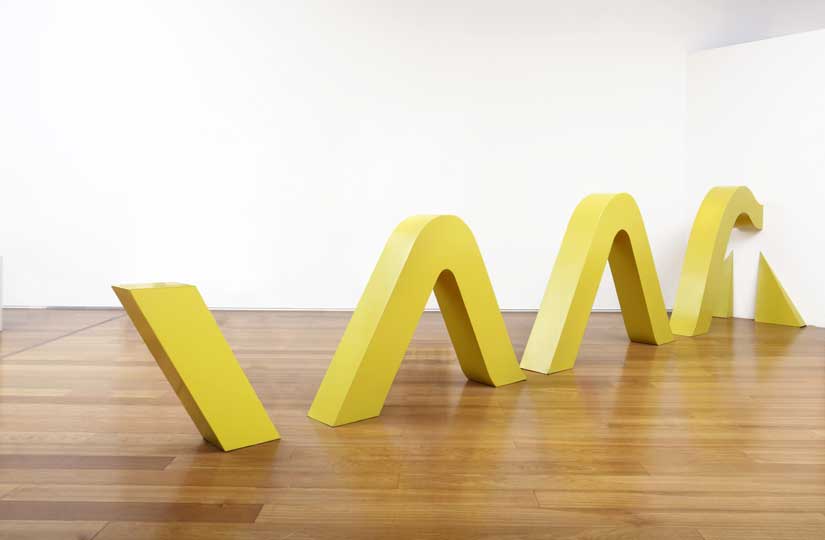At first glance, the old adage ‘Plus ça change, plus c’est la même chose’ seems the perfect way to describe Part II of ‘Other Primary Structures’, the Jewish Museum’s revival of its seminal 1966 show of minimalist sculpture. This second instalment covers the period from 1967–70, showcasing global artists working after, and in some cases, in dialogue with, the original exhibition.
In Part II, the museum’s stately exhibition rooms continue to provide their striking architectural contrast, the same photographs of the 1966 show set the scene for the sculptures on display. Most importantly, the works themselves are visually linked between the two parts; indeed, David Lamelas’ 1966 Situation of Four Aluminum plates even appears in both. The sense of continuity is entirely fitting, for as Part I made apparent, ‘Others’ is at least partially structured on a revolutionary aesthetics of sameness, wherein the uncanny familiarity of the works on show and their similarity to those in ‘Primary Structures’ is precisely what makes this revival new and groundbreaking.
The lines of kinship back to ‘Primary Structures’ are most readily apparent in the many works in Part II (including Lamelas’ holdover from Part I) by Latin American artists included in the 1967 Buenos Aires show Estructuras Primerias II. These artists were being placed in a conversation with Minimalism almost from its inception, and their inclusion in ‘Others’ is characteristic of the post-colonial turn to recognise artists whose significance to certain cultural narratives was previously overlooked because of national affiliation; again, this is the same principle at work as in Part I.
Yet despite their close ties to ‘Primary Structures’, these Latin American works also push back at the canonical aesthetics of Minimalism, revising and transforming them. The delicate sense of negative space in works like Renzi’s Degrees of Freedom in a Real Space makes progenitors like Walter de Maria’s Cage seem heavy-handed and obvious. Even the bright colors and bold form of Oscar Bony’s Sinusoid have a subtlety and sense of movement lacking in its Anglophone counterparts.
Indeed, throughout Part II of ‘Others’, difference reasserts itself as simliarity’s ever-present dialectical pair. Looking closely at some of the most magnificently ‘minimal’ pieces on display in Part II, those of the Japanese artists Kishio Suga, Jirō Takamatsu, or Nobuo Sekine (whose phenomenal Phase of Nothingness—Water steals the show), it becomes clear that despite sharing Minimalism’s simplicity of forms, they are engaging with entirely different questions. In these sculptures, the natural world is not simply an ever-present but a determining element. They embody a sustained engagement with the tension between the artificial and the natural, between art and life as aesthetic forces, a duality that is far removed from the bold and unabashedly manmade gestures of Minimalism as such.
Part I of ‘Other Primary Structures’ seemed to propose a quiet paradigm shift, in which recognition of sameness opened Minimalism to include a host of ‘new’ artists. What emerges from its pairing with Part II, however, is a far more radical realignment of the meaning of ‘minimalism’ to accommodate both similarities and dissimilarities alike. This minimalism is a far-reaching and diverse aesthetic impulse, a shape-shifting international zeitgeist whose variations and idiosyncrasies are themselves precisely the same as and utterly different from the Minimalism generated by Primary Structures. Or to put it more succinctly, ‘Plus c’est la même chose, plus ça change’.
‘Other Primary Structures: Others 2’ is at the Jewish Museum, New York, until 3 August.






